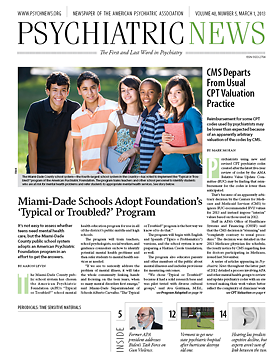Hurricane Sandy left a message for New York psychiatrists: No matter how well you learn from old disasters, a new one always adds some unexpected wrinkle.
“The New York Health and Hospital Commission [NYHHC] spent $20 million after Tropical Storm Irene in 2011 to upgrade Bellevue and Coney Island hospitals, and we ended up with 10 million gallons of water in the basement of Bellevue” after Hurricane Sandy, said Ann Marie Sullivan, M.D., senior vice president of NYHHC’s Queens Health Network and a former speaker of the APA Assembly. She spoke at the 14th annual Citywide Josef Weissberg Legislative Breakfast, sponsored by APA’s New York County District Branch in Manhattan on January 27.
Besides the flood water, which knocked out the fuel pumps serving generators on higher floors at Bellevue, Sullivan described three areas of concern after the October 2012 hurricane.
Credentialing—even within the same hospital system—proved difficult when clinicians were forced to evacuate to other facilities.
Finding shelter for large numbers of chronically mentally ill people displaced from group homes devastated by flood or fire was especially challenging, she said.
Also, communicating information about patients’ whereabouts or medical histories was difficult, especially in the first two days after the storm, said Sullivan.
“Eventually, the information was available within the NYHHC system but not always at other hospitals that were receiving patients,” she said.
Moving psychiatrists in training to other hospitals meant more than a geographic shift, said Carol Bernstein, M.D., an associate professor of psychiatry, vice chair for education, and director of residency training in the Department of Psychiatry at NYU Langone Medical Center.
Differences in training cultures at their new hospitals made adjustment difficult for residents.
“Unfavorable shifts went to the newcomers at first,” said Bernstein, a former APA president. “It was a fantasy that we could simply take what we were doing with residents at NYU and implant it at other hospitals.”
Follow-up for residents and faculty included a series of debriefings led by leading PTRSD researchers who work in New York, including Charles Marmar, M.D., and Claude Chemtob, Ph.D. As important as it is to plan for providing services for patients with mental illness, it’s also important to do this for people who are taking care of the patients and for our trainees. We’ve already had one formal debriefing session for the residents.
Information was on the mind of Richard Gottfried, J.D., chair of the New York State Assembly’s Committee on Health.
“Currently, databases of vulnerable populations are only optional for New York’s counties,” said Gottfried. “We need a system for tracking patients, notifying their families of where they are, and having medical records travel with patients.”
The Federal Emergency Management Agency (FEMA) provides financial support for the initial mental health response to disasters, said psychiatrist Lloyd Sederer, M.D., medical director of the New York Office of Mental Health. That office operates 24 hospitals around the state and is responsible for applying to FEMA for crisis-counseling funds. The post-Sandy work in New York operates under the name Project Hope.
The state applied for an “initial services” grant of $8.2 million right after the storm, allowing it to hire 600 full-time-equivalent counselors and make 20,000 outreach visits.
The federal money flows through states and local agencies, who in turn hire community providers, he explained. “They know their community’s resources and culture and speak their languages.”
New York state filed a second application for $47 million at the end of December to continue the program for nine more months. However, Sederer is unhappy with the program’s overall approach, because funds are available for crisis counseling, but not for longer-term treatment.
“We should permit crisis counselors to sustain their contact with affected individuals and families who screen positive and provide some form of limited care and problem-solving interventions until referrals can be made,” said Sederer.
“It’s time to do something not so constrictive and not so delimited by an old-fashioned model that goes back 30 or 40 years. A tremendous amount has been learned since 9/11 and Hurricane Katrina.”
He has proposed a model that uses smartphone technology to allow trained outreach workers to triage and evaluate disaster survivors. Triage questions would be followed by standardized screening instruments for posttraumatic stress disorder, major depression, anxiety, and bereavement, depending on the survivor’s exposure. Sandy resulted in few deaths but great property devastation and left a different set of psychiatric sequelae in its wake than did other disasters, he pointed out.
The use of technology would not only help workers in the field but also help in gathering data on interventions applied and on outcomes, he said. Recording who developed what condition, what treatment they received, and whether their condition improved would enable better preparation for the inevitable next disaster.
“Ultimately, I hope we can transform the mental health disaster response for New York and set an example for the rest of the nation,” said Sederer. ■

